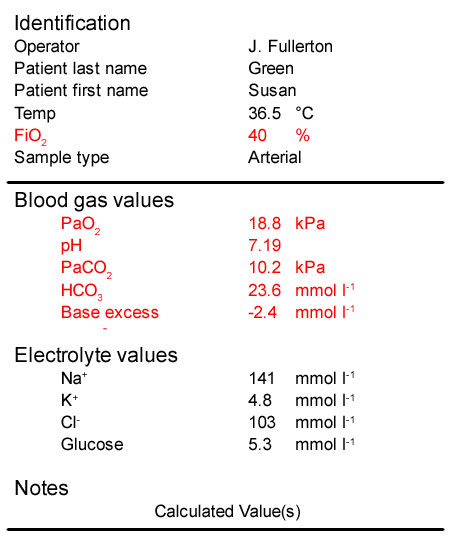
- Scenario one – analysing the ABG results

Feedback
That is not quite right. Have another go.
Feedback
That is not quite right.
- This patient’s PaO2 is >10kPa which means she is not hypoxaemic. However, we would expect a higher PaO[sub]2[/sub] breathing 40% oxygen (approximately 30 kPa), suggesting impaired oxygenation
- Her pH level is 7.19 which is below the normal level (pH 7.35). This indicates that she does have an acidaemia
- Her PaCO[sub]2[/sub] is increased well above normal. This is consistent with a low pH and therefore she does have a respiratory acidosis
- Her bicarbonate is within normal limits and her base excess is just below normal. There is no significant metabolic abnormality and so she does not have a metabolic acidosis
In summary:
This patient has an acute respiratory acidosis with impaired oxygenation. Treatment will include improving her airway and ventilation to reduce the PaCO[sub]2[/sub], particularly as she may have a head injury.
Feedback
That is not right. Have another go.
Feedback
That is not right.
- This patient’s PaO2 is >10kPa which means she is not hypoxaemic. However, we would expect a higher PaO[sub]2[/sub] breathing 40% oxygen (approximately 30 kPa), suggesting impaired oxygenation
- Her pH level is 7.19 which is below the normal level (pH 7.35). This indicates that she does have an acidaemia
- Her PaCO[sub]2[/sub] is increased well above normal. This is consistent with a low pH and therefore she does have a respiratory acidosis
- Her bicarbonate is within normal limits and her base excess is just below normal. There is no significant metabolic abnormality and so she does not have a metabolic acidosis
In summary:
This patient has an acute respiratory acidosis with impaired oxygenation. Treatment will include improving her airway and ventilation to reduce the PaCO[sub]2[/sub], particularly as she may have a head injury.
Feedback
That is right.
- This patient’s PaO2 is >10kPa which means she is not hypoxaemic. However, we would expect a higher PaO[sub]2[/sub] breathing 40% oxygen (approximately 30 kPa), suggesting impaired oxygenation
- Her pH level is 7.19 which is below the normal level (pH 7.35). This indicates that she does have an acidaemia
- Her PaCO[sub]2[/sub] is increased well above normal. This is consistent with a low pH and therefore she does have a respiratory acidosis
- Her bicarbonate is within normal limits and her base excess is just below normal. There is no significant metabolic abnormality and so she does not have a metabolic acidosis
In summary:
This patient has an acute respiratory acidosis with impaired oxygenation. Treatment will include improving her airway and ventilation to reduce the PaCO[sub]2[/sub], particularly as she may have a head injury.
References
Essentials: 5-step approach to ABG interpretation
Step 2 – is the patient hypoxaemic?
Step 3 – is the patient acidaemic or alkalaemic?
Step 4 – what happened to the PaCO2?
Step 5 – what has happened to the base excess or bicarbonate?
Normal values
PaO[sub]2[/sub] > 10 kPa (75 mmHg) on air
pH 7.35 – 7.45
PaCO[sub]2[/sub] 4.7 – 6.0 kPa
HCO[sub]3[/sub] 22 – 26 mmol l-1
BE +/- 2 mmol l[sup]-1[/sup]

